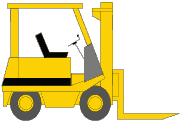![]()
AN OWNER'S GUIDE TO MAINTAINING, SERVICE AND REDUCE THE OPERATING COST OF A FORKLIFT FLEET.


When is it time to trade?
"If you need a new machine and don't
buy it, you pay for it without ever getting it."
- Henry Ford
Is your lift truck fleet making you money or costing
you a bundle?
How you answer that question may predict how you decide when to trade
lift trucks. If you said your trucks are making you money, you probably keep simple but comprehensive records tracking
the performance of each truck in your fleet. Those records help you schedule regular replacement of trucks, and
you likely have few trucks with over 10,000 hours on their hour meters.
On the other hand, if you said your fleet is costing you a bundle, your trucks probably don't have working hour
meters, and if they do, you pay little attention to them. Repair and maintenance expenses for all trucks are lumped
into one big budgetary black hole that balloons larger each year. Most of your trucks are more than five years
old; a few battered "Ol' Faithfuls" have been around for more than 10 years, and the average hour meter
reading across the fleet is 15,000 hours. Ultimately, the decision of when to trade lift trucks in your operation
is made by . . . the fleet itself.
If you only make repairs and do maintenance when a truck breaks down, or only trade trucks when an old truck is
finally beyond repair, then you aren't running your fleet, it's running you. But if you proactively manage your
fleet, keep good records, and use those records to establish an Economic Break-even Point (EBP) for each truck
in your fleet, you are in charge. With the right records you can predict and schedule the best time to replace
each unit.
The EBP of any lift truck can be pinpointed on a graph that measures accumulated
cost per hour on one axis and hours of use on the other axis. Maintenance costs per hour create an upward curve
while ownership costs per hour follow a downward curve on the graph. The EBP occurs when the accumulated maintenance
cost curve and accumulated ownership cost curve intersect.
The EBP for a lift truck can also be calculated mathematically. By combining the accumulated cost per hour of maintenance
with accumulated ownership costs, then dividing that total by the average economic life cycle of similar trucks
used under similar circumstances, owners can arrive at the EBP for any one truck.
Operating lift trucks beyond their EBP is expensive. Once a truck passes its
break-even point it costs more to own and maintain that truck than it would to own and maintain a new one. Repair
and maintenance costs escalate, downtime increases and hidden costs (rental of replacement trucks or loss of work
due to downtime) quickly eat away any advantages gained from depreciation or long-term ownership.
The EBP is different for every lift truck, depending on its usage and operating environment. Internal combustion
(IC) trucks in foundries may reach their economic break-even point in as little as 6,800 hours; electric trucks
in clean environments may stretch it to 15,000 hours. Only detailed record keeping enables you to accurately track
performance and monitor where each machine is at in its economic life cycle.
Robin Fruth, lift truck maintenance supervisor at Tropicana-Dole North America's Bradenton, Florida, facility,
tracks performance of over 200 lift trucks, ranging from 5,000-pound diesel sit-downs to small electric stand-up
units. Despite a 24-hours/day, seven days/week workload, only eight percent of his fleet is off-line at any time,
compared to a national average of over 30 percent.
Fruth credits this exceptionally low number of "down" vehicles to an aggressive planned maintenance schedule
and a lease program that trades trucks as soon as they reach the calculated end of their useful life.
It doesn't really matter whether you're leasing or owning, the concept of the EBP is the same. The whole idea is
to know exactly what each unit is costing you at every stage of its life and to be able to predict when it will
reach the point where it makes more economic sense to trade it than to keep it.
Keeping repair and maintenance costs for individual machines can be misleading if not used in conjunction with
hour meters. If a truck cost you $12,000 in maintenance and repair in one year and ran 6,000 hours, it cost you
$2 an hour and that's acceptable. But if that truck only ran 2,000 hours, you're up to $6 an hour and it may be
time to think about trading. The only way you can pinpoint your costs is with regular hour meter readings.
Productivity magazine

FORKLIFT OPERATION AND
SERVICE.
BE SURE TO VISIT THE HOME PAGE FOR INFORMATION ON LIFT
TRUCKS REPAIR, SERVICE, TROUBLESHOOTING, AND EVERYTHING YOU NEED TO KNOW ABOUT FORKLIFTS AND THEIR USE.